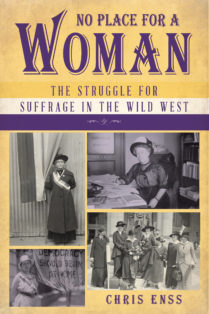Enter now to win a copy of the new book
No Place for a Woman: The Fight for Suffrage in the Wild West.

From 1912 to 1920, the voting map shifted with astonishing rapidity after the long years of the late nineteenth century when progress had seemingly stalled. The political exigencies of the Civil War and Reconstruction had made way for the reforming zeal of progressives at the turn of the twentieth century, and while war in Europe was on the horizon, the Gilded Age and industrialization had swept across the nation, allowing citizens a chance to participate in clubs and political organizations at a new level. And the expansion of states into the West had opened new opportunities for the people to have a voice in shaping laws. By 1912, decades had passed since the voters of Wyoming Territory had allowed women not only to step to the ballot box but also to appear on those ballots. Women all over the country had joined civic organizations in record numbers—the Woman’s Christian Temperance Union (WCTU), pro-suffrage organizations, as well as anti-suffrage organizations. The direst of predictions about what having masculine responsibilities would do to women had not come to fruition. Instead there had been a great awakening about the potential and abilities of the half of the population that had been silenced for so long.
In the West, where women found greater acceptance in the professions and demonstrated their grit amid the hardships of the frontier, the vote had happened quickly in the grand scheme of things. Perhaps the looser constraints of a less regimented social structure had contributed to women participating in all sorts of activities outside of their traditionally proscribed sphere, including political campaigns. Women worked for the candidates of their choice, for social reforms including the prohibition of alcohol, and for the vote. Their campaigns covered scattered voters stretched over millions of square miles—but the personal approach advocated by suffragists in some of the western states had proved to be effective. Women were lobbying their neighbors and their legislators personally to make the case for equality. And the public arm of the suffrage movement had gained hard-earned acceptance in many places.
Across the Great Plains, particularly in the middle West, the WCTU had reached its long fingers into the more organized churches, schools, and town structures crying for the reform that the vote could bring. Kansas passed a suffrage amendment in 1912, even before its wilder neighbors to the west, propelled by the reform zeal of women like Carrie Nation. Illinois followed in 1913. South Dakota had been debating and rejecting suffrage since its territorial days, but it would grant the vote to women in 1918, a year after its sibling North Dakota offered presidential suffrage to the women of that state. Nebraska also took the presidential route, giving women the right to vote for the man who would hold that office in 1917. Many other states opted for that introduction to the franchise for women, offering the chance to vote in presidential elections before the national amendment would grant the unlimited right in 1920. Illinois, Missouri, Minnesota, Wisconsin, Iowa, and other states east of the Mississippi were all beginning to push the door open in that way by 1919.
Part of the reason for the shift was that even before the Great War, women in the cities began entering the workforce in growing numbers, taking on jobs in numerous professional fields as well as continuing to work in the more traditionally feminine occupations. As a result, women’s economic status had undergone a significant transformation, and as skirt hems lifted, the arguments against the vote seemed to fall away. Politics—and the anti-progressive attitudes toward Prohibition and labor laws and social welfare programs—still stood in the way of equality, but the arguments against the vote became thinner and thinner.

To learn more about how women won the right to vote in the West read
No Place for a Woman

